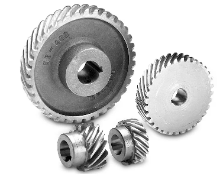
Helical Gears
A helical gear consists of teeth oriented at an angle to the shaft’s axis. Unlike the spur gear, more than one tooth is in contact when operating, which allows the helical gear to carry more load and have a smoother/quieter operation. Helix angle can range from a few degrees to 45 degrees, but the tooth bending-load capacity decreases at big angles (greater than 20 degrees).
We work closely with the leading manufacturers to provide gearing solutions to meet the requirements of your unique applications.
If you have any questions, write us via live chat (one of our team members will answer your questions), give us a call, or send us a quote request. The HVH team is always ready to help you.
 1(866)577-4040
1(866)577-4040
or
Manufacturers
In the world of engineering and mechanics, gears play a crucial role in transferring power and motion from one component to another. Among the various types of gears, helical gears stand out for their unique design and superior performance characteristics. In this article, we will discuss helical gears, exploring their structure, advantages, applications, and more.
What are Helical Gears?
A helical gear is a type of gear with teeth oriented at an angle to the shaft's axis, as opposed to the more common spur gear where the teeth are parallel to the shaft. This unique design allows multiple teeth to be in contact at the same time during operation, resulting in several advantages over other gear types.
Helix Angle and Tooth Orientation
The helix angle is a critical parameter in helical gear design. It determines the angle at which the teeth are aligned concerning the gear's axis. Helix angles can range from just a few degrees to as much as 45 degrees. However, it is essential to strike a balance, as excessively large angles, greater than 20 degrees, can decrease the tooth bending-load capacity.
While larger helix angles can increase the gear's load-carrying capacity, they also introduce a limitation in the form of reduced tooth bending-load capacity. Engineers must carefully consider this trade-off during gear selection and design.
The helical gear's slanted tooth orientation offers several advantages over traditional spur gears. One significant advantage is the increased load-carrying capacity, making helical gears suitable for applications that require the transmission of higher torque and power.
Advantages of Helical Gears
Increased Load Carrying Capacity
Due to the multiple tooth engagement, helical gears can distribute loads more evenly, reducing stress on individual teeth. This feature allows them to handle heavier loads effectively.
Smooth and Quiet Operation
The gradual tooth engagement of helical gears results in smoother and quieter operation compared to spur gears. The reduced noise levels make helical gears ideal for applications where noise reduction is critical.
Improved Efficiency
The design of helical gears reduces sliding friction between teeth, leading to higher efficiency and less energy loss during power transmission.
Helical Gears in Comparison to Other Gear Types
Spur Gears vs. Helical Gears
While spur gears are simpler and cost-effective, helical gears offer smoother operation and higher load-carrying capacity.
Bevel Gears vs. Helical Gears
Bevel gears are used for right-angle power transmission, while helical gears are preferred for parallel shafts.
Worm Gears vs. Helical Gears
Worm gears are ideal for high reduction ratios, while helical gears excel in applications with medium to high power requirements.
Factors to Consider in Helical Gear Design
Pitch Diameter and Module
The pitch diameter and module are essential parameters that determine the gear's size and tooth profile, affecting its performance characteristics.
Pressure Angle
The pressure angle influences tooth strength and smoothness of operation, making it crucial in gear design.
Number of Teeth
The number of teeth affects gear ratio and load distribution, influencing the gear's overall performance.
Helix Direction
Helical gears can have left-hand or right-hand helix directions, and selecting the appropriate direction is essential for proper gear engagement.
Conclusion
Helical gears are known for their efficiency, load-carrying capacity, and quiet operation. From automotive applications to robotics and industrial machinery, helical gears have proven to be a reliable and versatile choice. By understanding their design, advantages, and limitations, engineers can make informed decisions to optimize gear performance for various applications.




